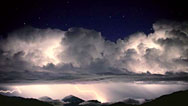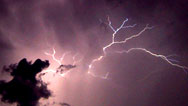Lightning
- Posted 10.18.05
- NOVA scienceNOW
(This video is no longer available for streaming.) What causes lightning? The mystery has confounded scientists for centuries, but researchers like Joe Dwyer are hot on the pursuit of an answer. At the International Center for Lightning Research and Testing in Florida, Dwyer and colleagues use rockets to lure down lightning bolts, the better to study them. And to test a hypothesis—that they're triggered by cosmic rays from outer space.
Transcript
Lightning
PBS air date: October 18, 2005
ROBERT KRULWICH: By the way, maybe you've noticed, in the old movies, when it's time to zap the monster on the table and bring it to life, they always use lightning. I mean always. And why? Well, because lightning is electrical. It turns things on. Though exactly what lightning does is left to your imagination, because, in the end, what makes life, that's still a mystery.
But interestingly—and I didn't know this—it turns out that what makes lightning is also still a mystery. In fact, it's kind of a big mystery. Here's correspondent Chad Cohen
CHAD COHEN (Correspondent): It's an elemental force of nature and still one of the most mysterious.
JOSEPH DWYER (Florida Institute of Technology): Lightning is very difficult to study, and I think we probably understand better how a star explodes halfway across the galaxy than how lightning propagates from six miles up.
CHAD COHEN: Lightning strikes the Earth 4,000,000 times a day. And after hundreds of years of scientific scrutiny, we still do not understand the essential secret of how it begins inside a storm. That's why Professors Ken Eack and Richard Sonnenfeld and their team from New Mexico Tech are on a 10,000-foot mountain, waiting for lightning to strike.
KENNETH EACK (New Mexico Institute of Mining and Technology): We're trying to find out something new about thunderstorms and lightning. That discovery I think is, is worth the risk.
CHAD COHEN: Whatever causes lightning to start has always been hidden inside the clouds, so unlocking that process requires waiting for the weather to reach maximum force, then launching sensitive instruments into the heart of the storm. It's hazardous and frustrating.
RICHARD SONNENFELD: Come on out. Let's go. Go, go, keep going. Hey, don't drop it. Don't drop it. Okay, let's go, let's go. Go ahead, you get in position, you get in position. Oh! Let's go in, in, in. It hit the ground.
DR. MARTIN UMAN (University of Florida): A thunderstorm has got the energy of an atomic bomb.
CHAD COHEN: Dr. Martin Uman is the director of the International Center for Lightning Testing and Research in Camp Blanding, Florida.
MARTIN UMAN: It's the brightest light that we see; it's the loudest noise that we hear. The only thing hotter than lightning on Earth would be a nuclear weapon explosion.
CHAD COHEN: But what triggers the release of all that power? We know that lightning is a huge electric spark, and sparks happen when positive and negative charges build up so much energy they leap through the air to get at each other. It can only happen when the negative charge in that ball on the right and the positive charge in that metal rod on the left get so overwhelmingly strong, they cut a path through the air in the middle.
DR. MARTIN UMAN: It's like a hose full of pressure and it can't hold on anymore.
CHAD COHEN: That's what most scientists thought was happening inside thunderstorms, as ice and water particles collide with each other, moving electric charges to opposite ends of a cloud. When the charge above and the charge below get strong enough, they leap through the air as a bolt of lightning. Except for one thing, when you actually examine the storm cloud, the strength of the positive and negative charges and the electric field around them isn't nearly enough to create that big spark.
JOSEPH DWYER: Well, the problem is, after decades and decades of measurements up in thunderstorms, nobody has ever managed to find an electric field anywhere near that big.
CHAD COHEN: Dr. Joe Dwyer is a professor at Florida Tech.
JOSEPH DWYER: Well, maybe we're looking for something that doesn't exist. Maybe there's something wrong with our understanding about how electrical discharges get started in places like thunderstorms.
CHAD COHEN: So if thunderclouds, even great big thunderclouds, don't have electric fields big enough to generate the giant spark that lightning actually is, where's all that energy coming from? Well, here in Florida they have a pretty dramatic way of trying to figure that out. They launch rockets with really long wires attached to try to create that express lane to ground that lightning likes so much.
To get lightning from these clouds to strike where scientists can measure it requires a simple trigger.
MARTIN UMAN: First of all, you need to have a propellant that can get this thing up there in a hurry. It has to be able to go 700 yards or so in about two seconds.
CHAD COHEN: What is this, actually? This is...is it just copper wire?
MARTIN UMAN: It's Kevlar®-covered copper wire.
CHAD COHEN: Kevlar, okay.
MARTIN UMAN: So, we load it, connect it electrically. When we're about to fire, switches are turned on here, manually. After that, everything is done with air pressure from downstairs.
JASON JERAULD: Okay, Casey, Tube 2 is armed. Three, two, one, fire!
CHAD COHEN: From 2,000 feet up, the wire triggers lightning with a path to ground higher than the Empire State building. And when it strikes, over a hundred million volts zap the array of test equipment on the ground.
CASEY RODRIGUEZ: Okay, Tube 4 is good. Go ahead and fire 11 when ready.
JASON JERAULD: Tube 11 is armed. Three, two, one, fire!
CHAD COHEN: The rockets are, for the first time, allowing physicists to experiment with lightning under repeatable and controllable conditions, so that now Joe Dwyer and other researchers can test an alternate theory of how lightning starts. That theory is called "Runaway Breakdown." Using this model, the energy field inside the storm cloud, that force between positive and negative, too weak to form a bolt of lightning, is struck by outside particles, bursts of electrons, which carry their own energy, very high energy. And with that added energy, you can now get that big spark.
JOSEPH DWYER: You end up with an avalanche of electrons moving near the speed of light. Now this model will work, as long as you have one fast electron to start it off, sort of the first...the finger that pushes the first domino to get the whole thing started.
CHAD COHEN: And here's where things get really interesting. Joe Dwyer and many other scientists believe that this outside energy force comes, not from the clouds, or anywhere else on Earth for that matter, but from cosmic rays: tiny, subatomic particles ejected from dying stars millions of years ago and billions of miles away. But how do you test this theory?
JOSEPH DWYER: We have 10 of these detectors spread out over the facility right now.
CHAD COHEN: Well, it turns out, when cosmic particles hit the Earth's atmosphere, they leave a unique signature in the form of gamma and x-rays. If scientists can detect these x-rays, they'll have the proof they need.
JOSEPH DWYER: This is what's called a sodium iodide detector. There's a piece of crystal in here that will absorb x-rays and gamma rays, and these things are not difficult to measure.
CHAD COHEN: That's where triggered lightning comes in. For the first time, the Florida Research Center's rockets allow Dwyer to place his x-ray detectors in lightning's path. He made his first series of measurements in 2002.
JOSEPH DWYER: A big negative voltage pulse would mean that we got a burst of x-rays in the detector. I actually didn't think we were going to see x-rays. The first plot we brought up, there was a nice little pulse that looked just like an x-ray right at the time that the lightning occurred. "Now, that's, that's interesting; that's probably a coincidence, you know? What's the chance of that?" So, we looked at the next lightning stroke—and there was an even bigger pulse—and the next one and the next one. And every one had these pulses that looked exactly like x-rays. I think I just about fell out of my chair at that point.
CHAD COHEN: Every single lightning strike Dwyer measured showed the presence of x-rays. But ground measurements can't reach high enough to where lightning actually starts. For that, you need to get instruments right up into the heart of the storm.
KENNETH EACK: We finally have the technology to build these instruments that are small enough and rugged enough to handle a thunderstorm environment.
CHAD COHEN: Lightning is striking all around them. It's time to launch.
KENNETH EACK: One event won't be enough. If we see an x-ray burst, and we call it quits on one event, well, that's, that's not good enough. And it's just going to take a lot of measurements to get in the right spot at the right time.
RICHARD SONNENFELD: Three, two, one...go!
CHAD COHEN: The balloon is sucked into the storm, trailing its cargo of instruments. Launches like these have finally traced x-rays all the way up to where lightning begins and have given scientists the strongest evidence yet that lightning's spark comes from forces outside the Earth itself.
JOSEPH DWYER: These cosmic rays may be the link which will connect a dying star halfway across the galaxy with lightning.
ROBERT KRULWICH: Thank you Chad Cohen. And now for our regular segment, "Don't Ask the Expert."
Astrophysicist Neil deGrasse Tyson said, "Whatever you do, please do not ask me about Hollywood space aliens." But we did.
NEIL deGRASSE TYSON: Hollywood? Don't get me started. Every time they put out an alien, it's for all intents and purposes identically human. If you were a jellyfish and saw the Hollywood aliens, you'd say they looked exactly like human beings. Two arms, two legs, a head, a neck, maybe they'll give it three eyes, instead of two, or antennae. They always have a face which is a very vertebrate kind of thing to have. So many other life forms on our planet, with whom we have DNA in common, do not have faces. Trees don't have faces; worms don't have faces; jellyfish don't have faces. The list is long.
You could draw from our own planet, finding creatures that look so unlike us that you'll do better tapping them as alien life forms than anything Hollywood comes up with in all of their movies. And I'm very disappointed. You know what the best Hollywood alien movie has been in my list? The Blob, the old Steve McQueen movie from the '50s, The Blob. That didn't have a face, did it? It was just this creature. And you didn't know what made it work, but it loved your blood. Even though it was a B-movie they did well
Credits
Lightning
- Edited by
- Stephen Mack
- Produced and Directed by
- Dean Irwin
NOVA scienceNOW
- Executive Producer
- Samuel Fine
- Executive Editor
- Robert Krulwich
- Senior Series Producer
- Vincent Liota
- Supervising Producer
- Andrea Cross
- Development Producer
- Kyla Dunn
- Associate Producer & Program Editor
- Win Rosenfeld
- Associate Producers
- Mary Robertson
Anthony Manupelli
Anna Lee Strachan - Unit Manager
- Candace White
- Production Secretary
- Ayo Babatunde
- Compositing
- Yunsik Noh
- Music
- Rob Morsberger
- NOVA scienceNOW Series Animation
- Edgeworx
- Camera
- Michael Chin
Anthony Forma
Donald Friedell
Rex Fortenberry
Mark Gunning
Scott Ransom
Edward Marritz
Daryl Patterson-Pendana
Joel Shapiro - Sound Recordists
- Sara Chin
Jeffrey Duncan
Neal Gettinger
Janice Mahan
Mark Roy
Virnado Woods - Audio Mix
- John Jenkins
- Animation
- Sputnik
- Additional Producing
- Talleah Bridges
- Production Assistants
- Robbie Gemmel
Shimona Shahi - Special Thanks
- American Indian Community House
DNA 2.0
Lassen Volcanic National Park
Tika Laudun
Louisiana Public Broadcasting
Louisiana State Wildlife and Fisheries
The Melton Family
The New York Academy of Medicine Library
33rd and Bird - Archival Material
- ABC News Video Source
BBC Motion Gallery
Getty Images
Linda Harrar Productions
Indiana State Museum and Historic Sites
Macaulay Library at the Cornell Lab of Ornithology
NASA
National Geographic Television Film Library
Prairie Pictures/Stormstock
William E. Sauro/The New York Times
WWL TV - NOVA Series Graphics
- yU + co.
- NOVA Theme Music
- Walter Werzowa
John Luker
Musikvergnuegen, Inc. - Additional NOVA Theme Music
- Ray Loring
- Post Production Online Editor
- Spencer Gentry
- Closed Captioning
- The Caption Center
- NOVA Administrator
- Dara Bourne
- Publicity
- Eileen Campion
Olivia Wong - Senior Researcher
- Barbara Moran
- Production Coordinator
- Linda Callahan
- Unit Manager
- Lola Norman-Salako
- Paralegal
- Richard Parr
- Legal Counsel
- Susan Rosen Shishko
- Post Production Assistant
- Alex Kreuter
- Associate Producers Post Production
- Nathan Gunner
Patrick Carey - Post Production Supervisor
- Regina O'Toole
- Post Production Editor
- Rebecca Nieto
- Post Production Manager
- Maureen Barden Lynch
- Supervising Producer
- Stephen Sweigart
- Producer, Special Projects
- Susanne Simpson
- Coordinating Producer
- Laurie Cahalane
- Senior Science Editor
- Evan Hadingham
- Senior Series Producer
- Melanie Wallace
- Managing Director
- Alan Ritsko
- Senior Executive Producer
- Paula S. Apsell
NOVA scienceNOW is a trademark of the WGBH Educational Foundation
This material is based upon work supported by the National Science Foundation under Grant No. 0229297. Any opinions, findings, and conclusions or recommendations expressed in this material are those of the author(s) and do not necessarily reflect the views of the National Science Foundation.
© 2005 WGBH Educational Foundation
All rights reserved
Related Links
-

How Lightning Works
It's like a giant spark in the sky, though with a few puzzling differences.
-

Lightning: Expert Q&A
Lightning expert Joe Dwyer of the Florida Institute of Technology answers questions about nature's brightest flashes.
-

Lightning Varieties
Your average jagged bolt is just one kind. There are also balls and elves, blue jets and red sprites, and more.
-

Lightning!
This video explains the mysterious force of lightning.



